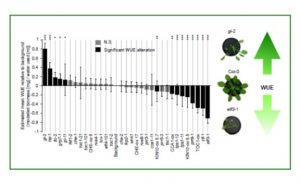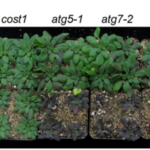The circadian clock influences the long-term water use efficiency of Arabidopsis (Plant Physiol.)
 The volume of water required for a given crop yield is largely influenced by the plant’s Water Use Efficiency (WUE). Considering that the majority of the water taken up by plants is lost through transpiration, WUE can be improved by modulating stomatal opening. Besides light and temperature, stomatal function is also regulated by circadian rhythms generated by the circadian oscillator. In order to investigate the contribution of the circadian clock on WUE in Arabidopsis, Simon et al. surveyed 32 loss- and gain-of-function mutants in genes associated with the circadian oscillator, and found significant WUE alterations in almost half of the genotypes (compared to wild types). These changes appeared to be associated with altered transpiration and altered biomass accumulation in lines with mis-regulated circadian clock genes. Across genotypes, a correlation exists between WUE and rosette architecture, which ultimately determine gas exchange. Nevertheless, the control of WUE mediated by the circadian oscillator seems to be more complex, and cannot be explained only by alteration of the rosette surface area. Therefore, further investigation is needed to develop crops with increased WUE. (Summary by Michela Osnato) Plant Physiol. 10.1104/pp.20.00030
The volume of water required for a given crop yield is largely influenced by the plant’s Water Use Efficiency (WUE). Considering that the majority of the water taken up by plants is lost through transpiration, WUE can be improved by modulating stomatal opening. Besides light and temperature, stomatal function is also regulated by circadian rhythms generated by the circadian oscillator. In order to investigate the contribution of the circadian clock on WUE in Arabidopsis, Simon et al. surveyed 32 loss- and gain-of-function mutants in genes associated with the circadian oscillator, and found significant WUE alterations in almost half of the genotypes (compared to wild types). These changes appeared to be associated with altered transpiration and altered biomass accumulation in lines with mis-regulated circadian clock genes. Across genotypes, a correlation exists between WUE and rosette architecture, which ultimately determine gas exchange. Nevertheless, the control of WUE mediated by the circadian oscillator seems to be more complex, and cannot be explained only by alteration of the rosette surface area. Therefore, further investigation is needed to develop crops with increased WUE. (Summary by Michela Osnato) Plant Physiol. 10.1104/pp.20.00030
[altmetric doi=”10.1104/pp.20.00030″ details=”right” float=”right”]



